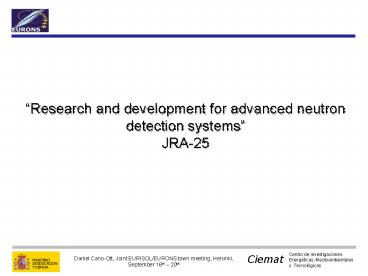Presentacin de PowerPoint - PowerPoint PPT Presentation
1 / 7
Title:
Presentacin de PowerPoint
Description:
Daniel Cano-Ott, Joint EURISOL/EURONS town meeting, Helsinki, September 16th ... of Huelva (Spain), University of Surrey (United Kingdom), University of Uppsala ... – PowerPoint PPT presentation
Number of Views:233
Avg rating:3.0/5.0
Title: Presentacin de PowerPoint
1
Research and development for advanced neutron
detection systems JRA-25
2
JRA25 RD for advanced neutron detection systems
List of participants Atomki (Hungary), CEA
Saclay (France), CIEMAT (Spain), GANIL (France),
GSI (Germany), IFIC (Spain), IN2P3 - Strasbourg
(France), INFN Bari (Italy), INFN Legnaro
(Italy), ITN (Portugal), JINR Dubna (Russia),
JYFL (Finland), KTH (Sweden), LPC Caen
(France), National Technical University of Athens
(Greece), NCSR Demokritos (Greece), Polytechnic
University of Catalonia (Spain), PTB (Germany),
SUBATECH-Nantes (France), University of Huelva
(Spain), University of Surrey (United Kingdom),
University of Uppsala (Sweden), University of
Warsaw (Poland), University of York
(UK) Participants from 24 institutions and 12
countries. Areas of specialisation liquid and
plastic scintillators (stand alone or ancillary),
proportional counters, gaseous detectors,
chemistry and development of new materials, MC
simulations, digital and analogue electronics,
reactor technology, irradiation facilities
3
JRA25 RD for advanced neutron detection systems
- Neutron detectors are used extensively at almost
every nuclear research facility across Europe in
basic and applied nuclear research - Nuclear structure, for decay studies and as
ancillary detectors for powerful in-beam
spectroscopy arrays. - Nuclear reactions, for the identification of the
reaction channels and reconstruction of the
complete kinematics. - Nuclear technology, in-core/off-core nuclear
reactor monitors. - Nuclear medicine, as radiation monitors and
dosimeters. - Material science, for neutron imaging techniques.
- Furthermore, the neutron rich side of the nuclide
chart is attracting more and more interest at the
existing (and future) facilities and (we think)
it is time to explore it with the adequate
instruments.
4
JRA25 RD for advanced neutron detection systems
- Modest improvements in neutron detection
techniques during the last decades in comparison
to other fields of nuclear instrumentation - It is difficult to detect neutrons
- The investments were reduced
- For the next generation of neutron detectors it
is necessary to have - I. More accurate design and analysis tools
- The standard Monte Carlo simulation tools
(GEANT4, MCNPX) are not accurate enough for the
detailed calculation of the response of neutron
detectors. Neutron physicists have been
developing their own codes, much more limited
and restricted but with better physics. We should
implement it into the existing ones. - Example production of electromagnetic cascades
in the neutron capture process violates energy
conservation in most of the codes. - We also need to guarantee the access to adequate
irradiation and detector testing facilities.
5
JRA25 RD for advanced neutron detection systems
- II. New or improved materials, both dead and
active. - The detector housings are still built in
stainless steel or aluminium and not in lower
background materials such as the carbon fibre. - Need of new (plastic) materials which allow
neutron/gamma pulse shape discrimination. NE213
is still considered as the best (liquid)
scintillator and is even older than the 252Cf
sources we use nowadays to calibrate it. - We do still use long counters while the use of
position sensitive proportional detectors could
allow low E resolution spectroscopy based on
time-space correlations. - The monitoring of new reactor concepts (fast,
accelerator driven) and spallation sources can be
done with better in-core/off-core monitors. - Many facilities, infrastructures and experiments
would benefit from neutron detector developments
higher efficiency, better energy resolution,
lower background, larger sensitivity.
6
JRA25 RD for advanced neutron detection systems
III. Optimised electronics It is time to design
a DAQ which allows the best neutron detector
performance. Up to now, neutron detectors were
considered to be less demanding and have
profited from the developments made for other
detector types, not always with the same
restrictions. Example the low energy threshold
to be set in a neutron TOF spectrometer is
conflicting with the use of large cables. Need of
1 channel digitiser boards (with/without CPU)
coupled directly to the detector. IV. A well
organised international community Progress
requires an international effort, and this is
particularly true for the neutron detector
community. Despite the efforts and attempts made
in the past, the community is still disperse and
bound weakly (around specific instruments). It is
necessary to change this situation and enhance
the collaborative efforts, ranging from the
mobility of scientists to the sharing of neutron
detector designs or even the hardware.
7
JRA25 RD for advanced neutron detection systems
Those are the goals of this Letter of Intent
JRA25 Research and development for advanced
neutron detection systems. (We are convinced
that) It represents an excellent unique
opportunity to explore the neutron rich
nuclei with more adequate tools! We certainly
do not claim to solve all the problems at once,
but have got already good ideas about the next
steps...

